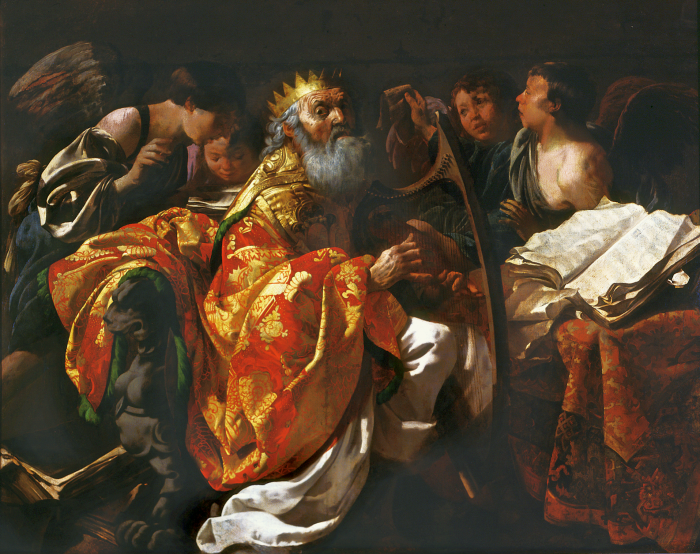
Lesson Objectives
- To understand the symbolism Matthew uses to convey the truth that Jesus Christ is the perfect Son of David.
- To see how the baptism of Jesus corresponds to the anointing of the Davidic kings.
- To understand how Matthew sees Jesus’ kingdom as the fulfillment of the promises in the prophets.
I. Beginning with the Old Testament
A. The Book of the Genealogy
The very first chapter of the New Testament begins by recapitulating the Old Testament:
“The book of the genealogy of Jesus Christ, the son of David, the son of Abraham” (see Matthew 1:1).
A long genealogy of Jesus Christ follows.
Many readers skip over these first seventeen verses of Matthew, and with some good reason. The genealogy seems to be simply reference material: it tells no story, and it does not preserve any sayings of Jesus.
But a closer look at this passage reveals that it carries some very important messages for us.
First of all, the placement of the genealogy at the beginning of Matthew’s Gospel, which later Christians placed at the beginning of the New Testament, tells us something very important about who Jesus Christ is. The first thing to know, Matthew tells us, is how Jesus is related to Old Testament Scripture.
Matthew even chooses his words to echo the Old Testament.
Compare Genesis 5:1, “This is the record of the descendants of Adam,” to Matthew 1:1: “The book of the genealogy of Jesus Christ, the son of David, the son of Abraham.”
In the Septuagint, the Greek translation of the Old Testament that the early Christians used, “the record of the descendants” in Genesis is the same as “the book of the genealogy” in Matthew.
Now notice how Matthew divides the genealogy into three parts. He sums up his method in verse 17:
“Thus the total number of generations"
from Abraham to David is fourteen generations;
from David to the Babylonian exile, fourteen generations;
from the Babylonian exile to the Messiah, fourteen generations (see Matthew 1:17).
B. The Perfect Number
Ancient Jewish writers attached great symbolic value to numbers. The number seven suggested completeness and covenant: in fact, the Hebrew word for making a covenant literally meant “to seven oneself.” Fourteen was doubly complete, since it was twice seven.
The number three suggested perfection. Often the two numbers are used together to signify absolute completeness: Solomon had seven hundred wives and three hundred concubines from all nations, symbolizing his authority over the whole world. (Not that it was a good idea for him to have all those wives; see 1 Kings 11:1-8.)
There is another numerical significance that is less obvious to us, but that probably would have been obvious to Matthew’s first audience.
Most scholars think that Matthew’s Gospel was written primarily for Jewish Christians. Those Jewish Christians would have learned Hebrew as part of their education: it was essential to be able to read the Scriptures in the original.
Just as the Romans and the Greeks did, Hebrew uses letters to represent numbers. (For example, in Roman numerals we write the year 2005 as MMV.)
It was common to take the numerical values of the letters in a name and add them up, coming up with a number that was supposed to have mystical or symbolic significance.
Hebrew has no letters for vowels, so the name David is spelled daleth-vau-daleth (DVD).
In Hebrew numerals the letter daleth (D) stands for 4, and the letter vau (V) stands for 6.
Numerically, then, David’s name is 4 + 6 + 4, or fourteen.
In other words, when Matthew divides the genealogy into three groups of fourteen generations, he numerically repeats David’s name a perfectly complete three times. Matthew is showing us that Jesus is the perfect Son of David, in whom all the promises God made to David are completed.
C. Still in Exile
For Matthew, history falls into three important periods:
from Abraham to David;
from David to the Babylonian exile;
from the Babylonian exile to the Messiah (see Matthew 1:17).
Another historian might have thought that the restoration of Jerusalem was as important as the deportation to Babylon. But for Matthew, the Babylonian exile did not end then. It ends only with the coming of the Messiah.
Why would Matthew see it that way?
First of all, we should remember that only a tiny remnant of Israel returned to Jerusalem and the surrounding area. Over the many years of exile in Babylon, many of the transplanted Israelites had grown rich, or at least comfortably prosperous. They saw no reason to leave their luxurious surroundings for the risky project of resettling a land most of them had never seen.
At the time of the Exile, other refugees had made their way to Egypt (see 2 Kings 25:26) - symbolically undoing the Exodus. They, too, had prospered. By the time of Christ, Alexandria in Egypt was second only to Rome in wealth and splendor, and about a quarter of its population was Jewish.
And, of course, the northern kingdom of Israel had been completely dispersed even before Judah was conquered (see 2 Kings 17:5-6). The northern tribes never returned to their homeland (see 2 Kings 17:22-23).
Some remnants of the northern tribes remained: Zebulun and Naphtali, the first to be conquered, had not been entirely displaced, and we read that the prophetess Anna was of the tribe of Asher (see Luke 2:36). But most of northern Israel was gone completely, dispersed among the nations so thoroughly that the remnants tribes could never even be identified.
So most of the original twelve tribes were lost completely; and even of those that could be accounted for, most lived outside the Promised Land.
Yet the prophets, as we saw in the previous lesson, had promised that all the descendants of Israel would be brought back together - “from all the lands to which I banished them; they shall again live on their own land” (see Jeremiah 23:8).
And along with that incredible promise came the even more incredible promise that the kingdom of David would be restored.
“Thus says the LORD: If you can break my covenant with day, and my covenant with night, so that day and night no longer alternate in sequence, then can my covenant with my servant David also be broken” (see Jeremiah 33:19-21).
Even after the kingdom of David’s descendants had fallen in a heap, the prophets were promising that the covenant with David could never be broken.
This promise was not fulfilled when Jerusalem was restored under Cyrus (see Ezra 1:1-4). Even after the Jewish nation, against all odds, won its independence (as recorded in the books of the Maccabees), no son of David sat on the throne, and most of the exiles were still in exile. And by the time of Christ, the Promised Land was once again merely a province of a great foreign empire.
In fact, the promise seemed impossible. How could all the tribes ever be reunited? The northern tribes had been so thoroughly scattered and mixed up with other nations that they had lost all memory of being descendants of Israel. How could the whole house of Israel be gathered together if most of them didn’t even know they were supposed to be gathered?
Lesson Outline
Other Lessons
- Lesson One: A Throne Established Forever
- To begin to appreciate the significance of God’s covenant with David for understanding the content and meaning of the New Testament.
- To understand the biblical idea of the monarchy and the Old Testament background for the Davidic covenant.
- To understand the basic outlines of the promises made to David and the shape of the Davidic kingdom under both David and Solomon.
- Lesson Two: Looking for the ‘New David’
- To understand the basic outline of Israel’s history in the centuries between the collapse of the Davidic kingdom and the beginning of the New Testament era.
- To appreciate how the collapse and disappearance of the Davidic Kingdom shaped Israel’s hopes and beliefs in the five centuries before Christ.
- To understand how God’s covenant promises were interpreted by Israel’s prophets and how those prophecies were understood in the last centuries before Christ.
- Lesson Four: The Throne of David, His Father
- To see how Luke emphasizes Jesus’ lineage as Son of David in the infancy narrative.
- To see how Jesus appears in public as the Son of David throughout Luke’s Gospel.
- To understand how, at the climax of Luke’s Gospel, Jesus takes his place as heir to the kingdom of David.
- Lesson Five: The Spread of the Kingdom in Acts
- To understand how Jesus’ parting words to His disciples form a map of the ideal Davidic kingdom.
- To see how the structure of the Acts of the Apostles follows that map.
- To see how Luke paints the nascent Church as the Davidic kingdom perfectly restored.
- Lesson Six: ‘The Key of David’: Church and Kingdom in the New Testament
- To understand the characteristics and identity of the kingdom of God as it is portrayed in the New Testament epistles and the Book of Revelation.
- To see how the Church is identified with the kingdom in the New Testament.
- To understand how the Church, as it is portrayed in the New Testament, bears the characteristics of the Davidic kingdom.

